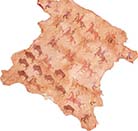SECTION 2: Westward Expansion and the American Indians

◄ A Native American warrior astride his war horse.

Painted buffalo hide ►
WITNESS HISTORY  AUDIO
AUDIO
My Heart Feels Like Bursting
Conflict between Native Americans and white settlers began almost from the moment the first Europeans arrived. The clash came to a head with the Indian Wars in the late 1800s. Satanta, a Kiowa chief, clearly expressed the Indian sentiment:
“I don’t want to settle. I love to roam over the prairies. There I feel free and happy, but when we settle down we grow pale and die…. A long time ago this land belonged to our fathers; but when I go up to the river I see camps of soldiers on its banks. These soldiers cut down my timber; they kill my buffalo; and when I see that my heart feels like bursting…. This is our country…. We have to protect ourselves. We have to save our country. We have to fight for what is ours.”
—Chief Satanta, 1867
Objectives
- Compare the ways Native Americans and white settlers viewed and used the land.
- Describe the conflicts between white settlers and Indians.
- Evaluate the impact of the Indian Wars.
Terms and People
- reservation
- Sand Creek Massacre
- Sitting Bull
- Battle of the Little Big Horn
- Chief Joseph
- Wounded Knee
- assimilate
- Dawes General Allotment Act
NoteTaking
Reading Skill: Identify Supporting Details As you read, fill in a concept web with details about Native Americans west of the Mississippi.

Why It Matters In 1787, the Constitution granted sole power for regulating trade with the Native Americans to the federal government. This is just one of many decrees that would establish the long, strained relationship between the federal government and Native Americans. During the 1830s, the federal government forced Native Americans from the East to resettle west of the Mississippi River and promised them the land there forever. In the 1840s through the 1860s, pressure from white settlers weakened this promise. In the ensuing contest, Native American cultures were irrevocably changed. Section Focus Question: How did the pressures of westward expansion impact Native Americans?
Cultures Under Pressure
By the end of the Civil War, about 250,000 Indians lived in the region west of the Mississippi River referred to as “The Great American Desert.” While lumped together in the minds of most Americans as “Indians,” Native Americans embraced many different belief systems, languages, and ways of life.
Diverse Cultures
Geography influenced the cultural diversity of Native Americans. In the Pacific Northwest, the Klamaths, Chinooks, and Shastas benefited from abundant supplies of fish and forest animals. Farther south, smaller bands of hunter-gatherers struggled to exist on diets of small game, insects, berries, acorns, and roots. In the




